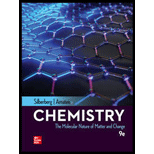
(a)
Interpretation:
The element that is less metallic between
Concept introduction:
The metallic character is characterized by the tendency of metals to lose their outermost valence shell electrons. Greater the ease of electron removal, higher will be the electropositivity of the corresponding elements and vice versa.
The metallic character increases from top to bottom in a group because the electrons are less tightly held by the nucleus of the atom and therefore removed easily.
The metallic character decreases from left to right in a period because the electrons are more tightly held with the nucleus of the atom and therefore the removal becomes difficult.
(b)
Interpretation:
The element that is less metallic between
Concept introduction:
The metallic character is characterized by the tendency of metals to lose their outermost valence shell electrons. Greater the ease of electron removal, higher will be the electropositivity of the corresponding elements and vice versa.
The metallic character increases from top to bottom in a group because the electrons are less tightly held by the nucleus of the atom and therefore removed easily.
The metallic character decreases from left to right in a period because the electrons are more tightly held with the nucleus of the atom and therefore the removal becomes difficult.
(c)
Interpretation:
The element that is less metallic between
Concept introduction:
The metallic character is characterized by the tendency of metals to lose their outermost valence shell electrons. Greater the ease of electron removal, higher will be the electropositivity of the corresponding elements and vice versa.
The metallic character increases from top to bottom in a group because the electrons are less tightly held by the nucleus of the atom and therefore removed easily.
The metallic character decreases from left to right in a period because the electrons are more tightly held with the nucleus of the atom and therefore the removal becomes difficult.
Want to see the full answer?
Check out a sample textbook solution
Chapter 8 Solutions
Chemistry: The Molecular Nature of Matter and Change
- Hello! I have a 500 Hz H-NMR for 1,5-bis-(4-methoxyphenyl)-penta-1,4-dien-3-one. I need to label the signals with the corresponding H's. Then, find out if the two alkenes are cis or trans by calculating the J values. I believe that I have the H-NMR labeled correctly, but not sure if I got the J values correct to determine if the two alkenes in the compound will make the compound cis or trans.arrow_forwardWhat is the only possible H-Sb-H bond angle in SbH3?arrow_forwardpls helparrow_forward
- Don't used hand raiting and don't used Ai solution and correct answerarrow_forwardDon't used hand raiting and don't used Ai solution and correct answerarrow_forwardPredict the product formed when the compound shown below undergoes a reaction with MCPBA in CH2Cl2. MCPBA is meta-chloroperoxybenzoic acid.arrow_forward
- k https://app.aktiv.com STARTING AMOUNT 6 58°F Clear + F1 X Dimensional Analysis - Aktiv Chemistry Your Aktiv Learning trial expires on 02/25/25 at 02:14 PM Question 19 of 22 Polyethylene terephthalate (PET) is used in plastic water bottles. A water bottle has a mass of 14.0 grams. Given a density of 1.38 g/cm³, what is the volume of the plastic used to make the water bottle in cm³ ? ADD FACTOR ANSWER RESET ว 100 14.0 0.01 10.1 1000 0.099 1.38 0.001 Q Search F5 -O+ F6 F7 + F3 F2 W E S4 ST #3 F4 % 5 Y R S & 7 cm³ g/cm³ g ם F8 * 00 8 F9 P ل DOD S F10 F11 F12 Insert D F G H J K + 11arrow_forwardA doctor gives a patient 10 Ci of beta radiation. How many betaparticles would the patient receive in 1 minute? (1 Ci = 3.7 x 1010d/s)arrow_forwardPart C IN H N. Br₂ (2 equiv.) AlBr3 Draw the molecule on the canvas by choosing buttons from the Tools (for bonds and + e (×) H± 12D T EXP. L CONT. דarrow_forward
 ChemistryChemistryISBN:9781305957404Author:Steven S. Zumdahl, Susan A. Zumdahl, Donald J. DeCostePublisher:Cengage Learning
ChemistryChemistryISBN:9781305957404Author:Steven S. Zumdahl, Susan A. Zumdahl, Donald J. DeCostePublisher:Cengage Learning ChemistryChemistryISBN:9781259911156Author:Raymond Chang Dr., Jason Overby ProfessorPublisher:McGraw-Hill Education
ChemistryChemistryISBN:9781259911156Author:Raymond Chang Dr., Jason Overby ProfessorPublisher:McGraw-Hill Education Principles of Instrumental AnalysisChemistryISBN:9781305577213Author:Douglas A. Skoog, F. James Holler, Stanley R. CrouchPublisher:Cengage Learning
Principles of Instrumental AnalysisChemistryISBN:9781305577213Author:Douglas A. Skoog, F. James Holler, Stanley R. CrouchPublisher:Cengage Learning Organic ChemistryChemistryISBN:9780078021558Author:Janice Gorzynski Smith Dr.Publisher:McGraw-Hill Education
Organic ChemistryChemistryISBN:9780078021558Author:Janice Gorzynski Smith Dr.Publisher:McGraw-Hill Education Chemistry: Principles and ReactionsChemistryISBN:9781305079373Author:William L. Masterton, Cecile N. HurleyPublisher:Cengage Learning
Chemistry: Principles and ReactionsChemistryISBN:9781305079373Author:William L. Masterton, Cecile N. HurleyPublisher:Cengage Learning Elementary Principles of Chemical Processes, Bind...ChemistryISBN:9781118431221Author:Richard M. Felder, Ronald W. Rousseau, Lisa G. BullardPublisher:WILEY
Elementary Principles of Chemical Processes, Bind...ChemistryISBN:9781118431221Author:Richard M. Felder, Ronald W. Rousseau, Lisa G. BullardPublisher:WILEY





